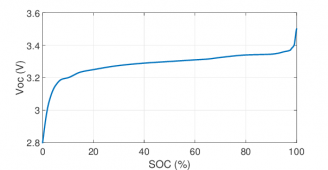The myth is that by some kind of spontaneous regeneration balancing between cells can occur without a closed circuit. That myth is being propagated by the innocent omission of a detail when there is an instruction about top balancing.
Let's start fresh. The below image shows the equivalent circuit model of a Lithium Ion battery:

Source:
https://www.researchgate.net/figure...del-of-the-lithium-ion-battery_fig1_276035953
I quote from the publication: "The equivalent circuit model is shown and consists of three parts: (1) the equivalent ohmic internal resistor R s ; (2) the resistor-capacitor (RC) parallel network C p // R p (where R p is the equivalent polarization resistance and C p is the equivalent polarization capacitance), which is used to simulate transient responses of the battery during charging-discharging transients; and (3) the OCV v oc (h(t)), which is a nonlinear function of SoC h(t). The equivalent circuit model considers the current as the model control input and the terminal voltage as the measured output."
Let's put two of these cells, at different state of charge (and let's assume a noticeably different terminal voltage), in parallel with one another. This forms closed circuit (agreed?) whereby an imbalance of voc means that one cell will have a Vb (terminal voltage) higher than the other will lead to a current to flow from the higher potential to the lower until the two terminal voltages equalize - essentially charge from the cell with the higher potential moves to the cell with the lower potential, increasing voc in the cell that was at lowest, and decreasing voc in the cell that was at highest potential.
The issue with LiFePO4 is that while theoretically there is a difference in voc at low and high state of charge,
in practice this is not the case across the majority of the state of charge except in the knees - meaning either at low state of charge, or high state of charge. See diagram below:

While there is a small difference in voltage between say 40% and 60% state of charge, the delta between these is so small that if we were to take a cell at 40% SoC and 60% SoC and we were to put these in parallel, the resulting current flowing from the cell at higher potential to the one at lower potential is a) very small and b) because of that any imbalance in SoC (20% in this case) would take a very long time (impractically so) to balance out.
However, the same can not be said for cells at the 'upper knee' in the chart. where large deltas in voltage actually occur at very low deltas in SoC. This is where you balance with a BMS, this is where you top balance with a power supply in the mix.
In summary, putting LiFePO4 cells in parallel balances them, in some cases, but not at random states of charge somewhere on the 'flat part' of the curve. This is not the same for all chemistries: LTO for example has a curve that is not flat like this and there paralleling cells without additional power supply has more effect. Same is true for lead acid. For LiFePO4, you balance in the knees where you have a clear voltage indicating state of charge, and where relatively large voltage deltas correspond to small percentages of state of charge.




